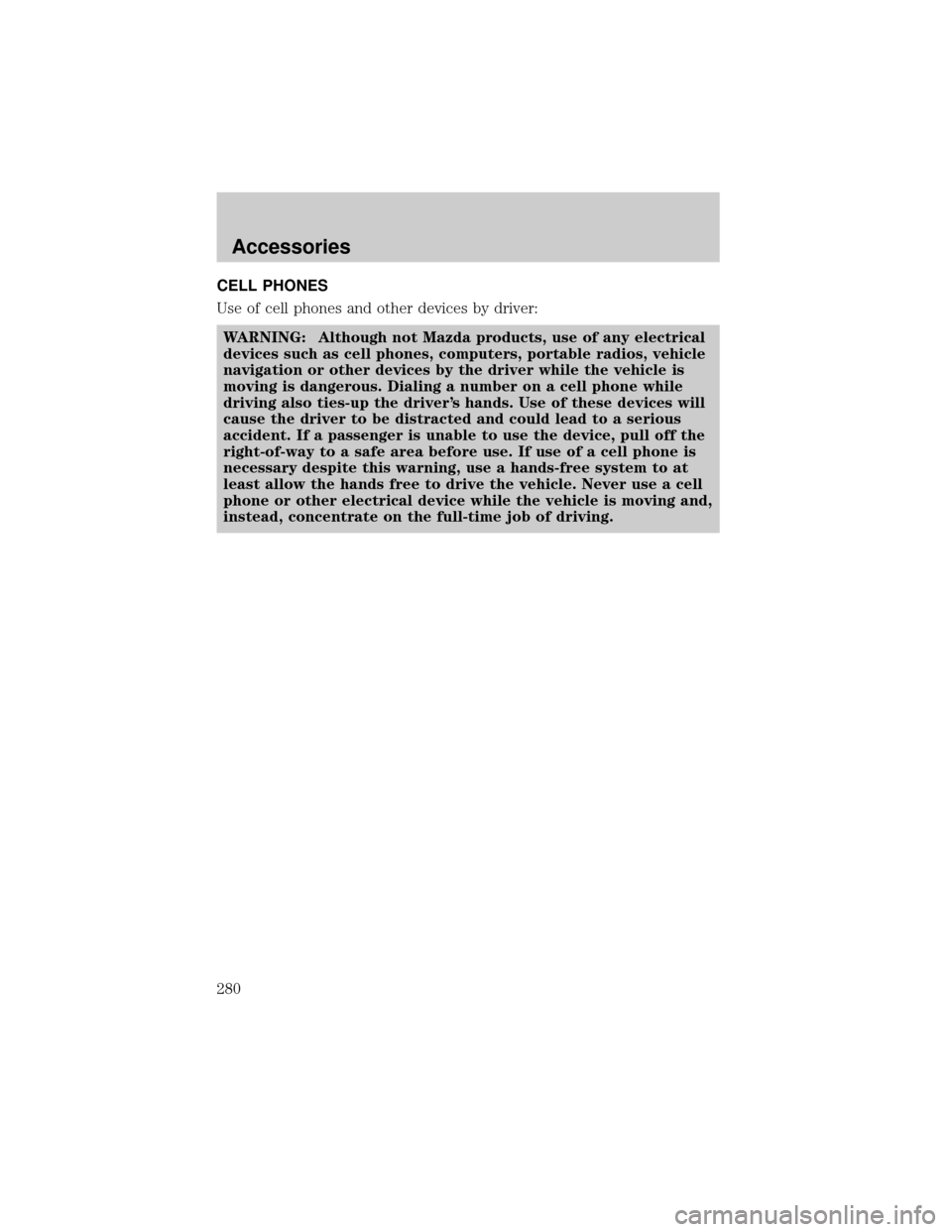vin MAZDA MODEL B-SERIES 2002 Owners Manual (in English)
[x] Cancel search | Manufacturer: MAZDA, Model Year: 2002, Model line: MODEL B-SERIES, Model: MAZDA MODEL B-SERIES 2002Pages: 287, PDF Size: 2.47 MB
Page 264 of 287
![MAZDA MODEL B-SERIES 2002 Owners Manual (in English) Automatic transmission fluid expands when warmed. To obtain an
accurate fluid check, drive the vehicle until it is at normal operating
temperature (approximately 30 km [20 miles]). If your vehicle has MAZDA MODEL B-SERIES 2002 Owners Manual (in English) Automatic transmission fluid expands when warmed. To obtain an
accurate fluid check, drive the vehicle until it is at normal operating
temperature (approximately 30 km [20 miles]). If your vehicle has](/img/28/13733/w960_13733-263.png)
Automatic transmission fluid expands when warmed. To obtain an
accurate fluid check, drive the vehicle until it is at normal operating
temperature (approximately 30 km [20 miles]). If your vehicle has been
operated for an extended period at high speeds, in city traffic during hot
weather or pulling a trailer, the vehicle should be turned off for about 30
minutes to allow fluid to cool before checking.
1. Drive the vehicle 30 km (20 miles) or until it reaches normal
operating temperature.
2. Park the vehicle on a level surface and engage the parking brake.
3. With the parking brake engaged and your foot on the brake pedal,
start the engine and move the gearshift lever through all of the gear
ranges. Allow sufficient time for each gear to engage.
4. Latch the gearshift lever in P (Park) and leave the engine running.
5. Remove the dipstick, wiping it clean with a clean, dry lint free rag. If
necessary, refer toIdentifying components in the engine
compartmentin this chapter for the location of the dipstick.
6. Install the dipstick making sure it is fully seated in the filler tube.
7. Remove the dipstick and inspect the fluid level. The fluid should be
in the designated area for normal operating temperature or ambient
temperature.
Low fluid level
Do not drive the vehicle if the fluid
level is at the bottom of the dipstick
and the ambient temperature is
above 10ÉC (50ÉF).
Correct fluid level
The transmission fluid should be checked at normal operating
temperature 66ÉC-77ÉC (150ÉF-170ÉF) on a level surface. The normal
operating temperature can be reached after approximately 30 km (20
miles) of driving.
You can check the fluid without driving if the ambient temperature is
above 10ÉC (50ÉF). However, if fluid is added at this time, an overfill
condition could result when the vehicle reaches normal operating
temperature.
Maintenance and Specifications
264
Page 268 of 287

INFORMATION ABOUT UNIFORM TIRE QUALITY GRADING
New vehicles are fitted with tires that
have a rating on them called Tire
Quality Grades. The Quality grades
can be found where applicable on the
tire sidewall between tread shoulder
and maximum section width. For
example:
²Treadwear 200 Traction AA Temperature A
These Tire Quality Grades are determined by standards that the United
States Department of Transportation has set.
Tire Quality Grades apply to new pneumatic tires for use on passenger
cars. They do not apply to deep tread, winter-type snow tires,
space-saver or temporary use spare tires, tires with nominal rim
diameters of 10 to 12 inches or limited production tires as defined in
Title 49 Code of Federal Regulations Part 575.104(c)(2).
U.S. Department of Transportation-Tire quality grades:The U.S.
Department of Transportation requires Mazda to give you the following
information about tire grades exactly as the government has written it.
Treadwear
The treadwear grade is a comparative rating based on the wear rate of
the tire when tested under controlled conditions on a specified
government test course. For example, a tire graded 150 would wear one
and one-half (1 1/2) times as well on the government course as a tire
graded 100. The relative performance of tires depends upon the actual
conditions of their use, however, and may depart significantly from the
norm due to variations in driving habits, service practices, and
differences in road characteristics and climate.
Traction AA A B C
The traction grades, from highest to lowest are AA, A, B, and C. The
grades represent the tire's ability to stop on wet pavement as measured
under controlled conditions on specified government test surfaces of
asphalt and concrete. A tire marked C may have poor traction
performance.
NOTE:The traction grade assigned to this tire is based on
straight-ahead braking traction tests, and does not include acceleration,
cornering, hydroplaning or peak traction characteristics.
Maintenance and Specifications
268
Page 272 of 287

SNOW TIRES AND CHAINS
WARNING: Driving too fast for conditions creates the
possibility of loss of vehicle control. Driving at very high speeds
for extended periods of time may result in damage to vehicle
components.
NOTE:Snow tires must be the same size and grade as the tires you
currently have on your vehicle.
The tires on your vehicle have all weather treads to provide traction in
rain and snow. However, in some climates, you may need to use snow
tires and chains. If you need to use snow tires and chains, it is
recommended that steel wheels are used of the same size and
specifications as those originally installed.
Follow these guidelines when using snow tires and chains:
²Do not use tire chains on aluminum wheels. Chains may chip the
wheels.
²Use only SAE Class S chains.
²Install chains securely, verifying that the chains do not touch any
wiring, brake lines or fuel lines.
Drive cautiously. If you hear the cables rub or bang against the
vehicle, stop and retighten them. If this does not work, remove
the cables to prevent vehicle damage.
²If possible, avoid fully loading your vehicle.
²Remove the tire chains when they are no longer needed. Do not use
tire chains on dry roads.
²The suspension insulation and bumpers will help prevent vehicle
damage. Do not remove these components from your vehicle when
using snow tires and chains.
Maintenance and Specifications
272
Page 280 of 287

CELL PHONES
Use of cell phones and other devices by driver:
WARNING: Although not Mazda products, use of any electrical
devices such as cell phones, computers, portable radios, vehicle
navigation or other devices by the driver while the vehicle is
moving is dangerous. Dialing a number on a cell phone while
driving also ties-up the driver's hands. Use of these devices will
cause the driver to be distracted and could lead to a serious
accident. If a passenger is unable to use the device, pull off the
right-of-way to a safe area before use. If use of a cell phone is
necessary despite this warning, use a hands-free system to at
least allow the hands free to drive the vehicle. Never use a cell
phone or other electrical device while the vehicle is moving and,
instead, concentrate on the full-time job of driving.
Accessories
280
Page 281 of 287

A
ABS (see Brakes) .....................152
Air bag supplemental restraint
system ........................................125
and child safety seats ............127
description ..............................125
disposal ....................................130
driver air bag ..........................128
indicator light ...................16, 129
operation .................................128
passenger air bag ...................128
passenger deactivation
switch ......................................130
Air conditioning
manual heating and air
conditioning system .................74
Ambulance packages ....................7
Antifreeze
(see Engine coolant) ................246
Anti-lock brake system
(see Brakes) ......................152±153
Anti-theft system
warning light .............................18
Audio system
(see Radio) ......................23, 48, 57
Automatic transmission ............157
driving an automatic
overdrive .................................158
fluid, adding ............................263
fluid, checking ........................263
fluid, refill capacities ..............273
fluid, specification ..................277
Auxiliary power point ...........88, 98
Axle
lubricant specifications ..276±277
refill capacities ........................273
traction lok ..............................155B
Battery .......................................244
acid, treating emergencies .....244
charging system
warning light .............................17
jumping a disabled battery ....201
maintenance-free ....................244
servicing ..................................244
voltage gauge ............................21
Bed extender ..............................99
BeltMinder .................................121
Brakes ........................................152
anti-lock ...........................152±153
anti-lock brake system
(ABS) warning light .........16, 153
brake warning light ..................15
fluid, checking and adding ....262
fluid, refill capacities ..............273
fluid, specifications .........276±277
lubricant specifications ..276±277
parking ....................................154
shift interlock ..........................157
Break-in period .............................5
Bulbs ............................................79
C
Capacities for refilling fluids ....273
Cargo area shade ........................98
Cargo net .....................................98
CD-6 disc .....................................57
CD-single .....................................27
CD-single premium .....................48
Cell phone warning ...................280
Certification Label ....................278
Changing a tire .........................194
Index
281
Page 282 of 287

Child safety restraints ..............136
child safety belts ....................136
Child safety seats ......................137
attaching with tether straps ..141
in front seat ............................139
in rear seat ..............................139
Cleaning your vehicle ...............223
engine compartment ..............219
exterior ............................219, 223
exterior lamps .........................221
instrument cluster lens ..........222
instrument panel ....................222
interior .....................................222
mirrors .....................................221
plastic parts ............................221
safety belts ..............................223
washing ....................................218
waxing .....................................218
wheels ......................................219
windows ..................................223
wiper blades ............................221
Climate control (see Air
conditioning or Heating) ......72, 74
Clock ....................26, 33, 47, 55, 68
Clutch
fluid ..........................................263
operation while driving ..........161
recommended shift speeds ....162
Compass, electronic ..............90±91
calibration .................................92
set zone adjustment .................91
Console ........................................98
Coolant
checking and adding ..............246
refill capacities ................249, 273
specifications ..................276±277
Cruise control
(see Speed control) ....................93Customer
Assistance ..........180, 207±208, 211
Getting roadside assistance ...180
D
Daytime running lamps
(see Lamps) ................................77
Dipstick
automatic transmission
fluid ..........................................263
engine oil .................................238
Doors
door ajar warning .....................18
lubricant specifications ..........276
Driveline universal joint and
slip yoke ....................................267
Driving under special
conditions ..........................167±168
mud ..........................................167
sand .........................................167
snow and ice ...........................168
through water .................167, 169
E
Emergencies, roadside
jump-starting ..........................201
Emission control system ..........259
Engine ........................................277
check engine/service engine
soon light ..................................14
cleaning ...................................219
coolant .....................................246
idle speed control ...................244
lubrication
specifications ..................276±277
refill capacities ........................273
service points ..................234±236
Index
282
Page 283 of 287

starting after a collision .........182
Engine block heater .................150
Engine oil ..................................238
checking and adding ..............238
dipstick ....................................238
filter, specifications ................242
recommendations ...................242
refill capacities ........................273
specifications ..................276±277
Exhaust fumes ..........................151
F
Fluid capacities .........................273
Foglamps .....................................77
Four-Wheel Drive
vehicles ................................18, 163
description ..............................164
driving off road .......................166
electronic shift ........................164
indicator light .........................164
preparing to drive your
vehicle .....................................156
Fuel ............................................251
calculating fuel economy .......256
cap .....................................17, 253
capacity ...................................273
choosing the right fuel ...........254
comparisons with EPA fuel
economy estimates .................259
detergent in fuel .....................255
filling your vehicle with
fuel ...........................251, 253, 256
filter, specifications ................255
fuel pump shut-off switch .....182
gauge .........................................21
improving fuel economy ........256
octane rating ...................254, 277
quality ......................................254running out of fuel .................255
safety information relating to
automotive fuels .....................251
Fuses ..................................183±184
G
Gas cap (see Fuel cap) ......17, 253
Gas mileage (see Fuel
economy) ...................................256
Gauges .........................................19
battery voltage gauge ...............21
engine coolant temperature
gauge .........................................20
engine oil pressure gauge ........20
fuel gauge ..................................21
odometer ...................................22
speedometer .............................21
tachometer ................................22
trip odometer ............................22
GAWR (Gross Axle Weight
Rating) .......................................169
calculating ...............................171
definition .................................169
driving with a heavy load ......169
location ....................................169
GVWR (Gross Vehicle Weight
Rating) .......................................169
calculating .......................169, 171
definition .................................169
driving with a heavy load ......169
location ....................................169
H
Hazard flashers .........................181
Headlamps ...................................77
aiming ........................................78
bulb specifications ....................80
Index
283
Page 286 of 287

Snowplowing .................................7
Spare tire
(see Changing the Tire) ...........195
Spark plugs, specifications .......277
Special notice
ambulance conversions ..............7
utility-type vehicles ....................7
Specification chart,
lubricants ...........................276±277
Speed control ..............................93
Speedometer ...............................21
Starting your
vehicle ........................147±148, 150
jump starting ..........................201
Steering wheel
controls ................................87, 93
tilting .........................................87
T
Tachometer .................................22
Temperature control
(see Climate control) .................72
Tires ...........................194, 268±269
changing ..................194±195, 198
checking the pressure ............269
replacing ..................................271
rotating ....................................269
snow tires and chains ............272
tire grades ...............................269treadwear ................................268
Towing .......................................171
recreational towing .................178
trailer towing ..........................171
wrecker ....................................206
Traction-lok rear axle ...............155
Transfer case
fluid checking .........................267
Transmission
automatic operation ...............157
fluid, checking and adding
(automatic) .............................263
fluid, checking and adding
(manual) .................................266
fluid, refill capacities ..............273
lubricant
specifications ..................276±277
manual operation ....................161
Trip odometer .............................22
Turn signal ............................18, 79
V
Vehicle dimensions ...................277
Vehicle Identification Number
(VIN) ..........................................279
Vehicle loading ..........................169
camper bodies ........................179
Ventilating your vehicle ...........151
Index
286
Page 287 of 287

W
Warning chimes ...........................19
Warning lights (see Lights) .......14
Washer fluid ..............................237
Washing your vehicle ................218
Water, Driving through .............169
Waxing your vehicle .................218Windows
power .........................................89
Windshield washer fluid and
wipers
checking and adding fluid .....237
checking and cleaning ..............86
operation ...................................86
replacing wiper blades .............87
Wrecker towing .........................206
Index
287